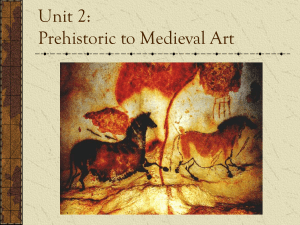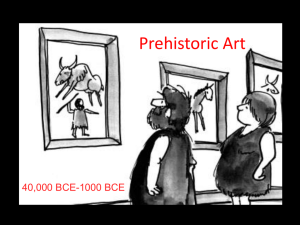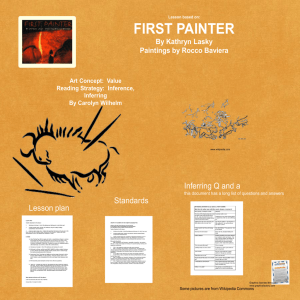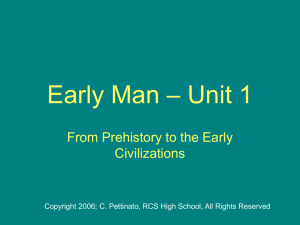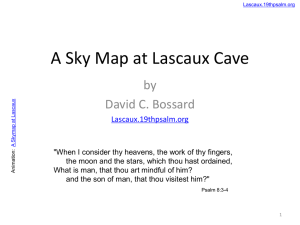Lasceaux cave paintings
advertisement
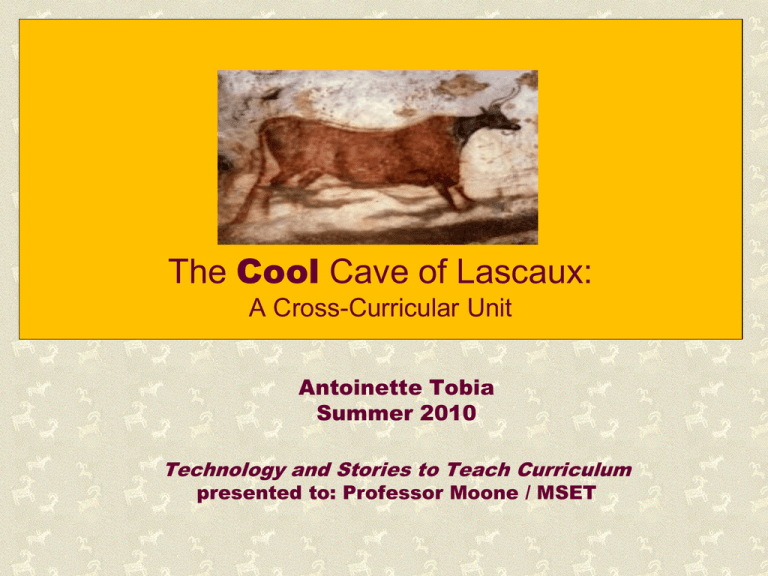
The Cool Cave of Lascaux: A Cross-Curricular Unit Antoinette Tobia Summer 2010 Technology and Stories to Teach Curriculum presented to: Professor Moone / MSET Target Audience • Subject Areas: Visual Arts, Technology, Social Studies, Language Arts Literacy, Science • Grades 3-5, Special Education • This unit may be differentiated to accommodate all learners with modified requirements, extended work time, support structures, and personnel. • Timeline: 8 - 45-minute periods/once a week Goals and Objectives The learner will be able to: • explain why cave paintings were createdwhy they are significant. • draw parallels between prehistoric art and art that is made today. • identify cave paintings (subjects, style, materials). • create art based on the cave paintings. Essential Questions • Why did people who lived many years ago make art? • Does art tell a story? • Does art communicate ideas? • Why do people who live today make art? Unit Plan • Students will be introduced to and explore the Lascaux Cave in France. • These animal paintings are considered to be the beginning of art. They were created about 17,000 years ago. Click here for Unit Plan Visit the Cave • Click here to visit Lascaux Ask before viewing: • What animal images would you expect to see at Lascaux? • This Website is a virtual tour and very engaging. • Students are encouraged to make sketches of the animals to be used in the art project. Interesting Cave Facts • In 1940, 4 French teenagers accidentally discovered the cave. • The cave contained more than 600 paintings and 1500 engravings that are carved into the walls. • The most popular animal is the horse, followed by the bison. • “Lascaux” is pronounced Lasco! • The flute is the earliest known instrument, click to hear a “bone” flute. Storytelling • First Painter by Kathryn Lasky: Click on the book to view Storytelling Chart II: This fictional book is set in prehistoric times and imagines what inspired Mishoo, a young girl, to go to the cave and paint. The book is based on archaeological findings and is beautifully illustrated. The paintings are symbolic and powerful. Story Support Materials • “Telling a story is a way of establishing meaning” (Egan,37). First Painter Worksheet Cool Cave Vocabulary Worksheet “Cave Paintings and Rock Art” • Click on picture to view this website: • This website details the cave painters and their lives. • It discusses the colors and materials used in the cave paintings. • The dangers of caves are cited. Cave Painting Project • Students will create a large-scale “cave painting” based on the cave at Lascaux. • Click here for a lesson on using natural materials to create “prehistoric paint.” • Click on this picture for a cave painting lesson plan (scale may be adjusted). Science and the Cave • In 1948, the Cave was open to daily tours for thousands of people. • This created a huge problem for the Cave! • The breath of the tourists created carbon dioxide that caused the paintings to deteriorate. • Another problem was carried in by the shoes of the tourists - algae - that began to grow on the walls and cover the paintings. • Calcite crystals also began to cover some of the paintings due to the high temperatures, humidity, and carbon dioxide levels caused by all of the tourists. Lascaux II • In order to save Lascaux from destruction, the Cave was closed to the public in 1963. • In 1983, Lascaux II was opened to the public – technology re-created the original cave and artwork. It is nearby the original site. • Today, only a small number of scientists and researchers are allowed to visit the original Lascaux Cave. “From Cave Art to Your Art” • Extension Activity: This website allows students to create their own videos – it is an exciting multimedia experience. Click here for website Dino Games • Did cave painters live with dinosaurs? • Movies and cartoons often show early humans and dinosaurs living at the same time. • This is a myth (a popular belief that is false). • The dinosaurs were extinct, or no longer alive, before people lived. The dinosaurs lived 65 million years before humans! • Click here to play some fun dinosaur games. Evaluations • Students will discuss how their earlier ideas of prehistoric people have changed after this unit. • In teams, students will complete a rubric to assess their performances throughout the unit. • The teams will share their findings with their classmates. Click on clipboard for Rubrics (for Teacher and Students) Brainy Bits Bloom's Revised Taxonomy: • Creating: students produce a multimedia video. • Evaluating: students critique their performances and learning using a student rubric. • Analysing: Students organize information in order to answer story worksheet discussion questions. • Applying: students execute the painting of original cave art. • Understanding: students explain the culture of prehistoric people and the cave from “First Painter.” • Remembering: students recall facts and details from book, websites, and discussions. Brainy Bits Sense and Meaning: • “What we call imagination is also a tool of learning…” (Egan, 17). • First Painter, the story that is used in this unit, draws “on the engaging and communicative powers of the story form” (Egan, 23). • There are a number of ways that this story promotes the storage of information. Click here to learn more More Brainy Bits & NJCCCS • Click below to discover more Brainy Bits: • Gardner’s Multiple Intelligences • Gregorc's Learning Styles • NJCCCS Works Cited • Click on the image for Works Cited:
